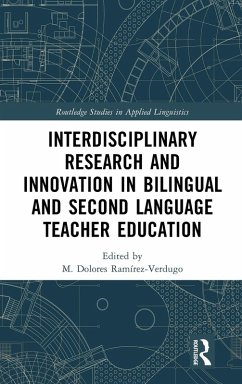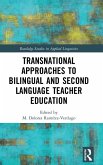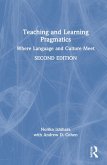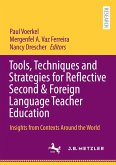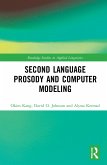Interdisciplinary Research and Innovation in Bilingual and Second Language Teacher Education
Herausgeber: Ramírez-Verdugo, M. Dolores
Interdisciplinary Research and Innovation in Bilingual and Second Language Teacher Education
Herausgeber: Ramírez-Verdugo, M. Dolores
- Gebundenes Buch
- Merkliste
- Auf die Merkliste
- Bewerten Bewerten
- Teilen
- Produkt teilen
- Produkterinnerung
- Produkterinnerung
The book provides a comprehensive overview of international pedagogical approaches, research, innovation experiences, and best practice in bilingual and second language education to enhance bilingual teacher education programs.
Andere Kunden interessierten sich auch für
![Transnational Approaches to Bilingual and Second Language Teacher Education Transnational Approaches to Bilingual and Second Language Teacher Education]() Transnational Approaches to Bilingual and Second Language Teacher Education180,99 €
Transnational Approaches to Bilingual and Second Language Teacher Education180,99 €![Reflections on Language Teacher Identity Research Reflections on Language Teacher Identity Research]() Reflections on Language Teacher Identity Research199,99 €
Reflections on Language Teacher Identity Research199,99 €![Teaching and Learning Pragmatics Teaching and Learning Pragmatics]() Noriko IshiharaTeaching and Learning Pragmatics174,99 €
Noriko IshiharaTeaching and Learning Pragmatics174,99 €![Tools, Techniques and Strategies for Reflective Second & Foreign Language Teacher Education Tools, Techniques and Strategies for Reflective Second & Foreign Language Teacher Education]() Tools, Techniques and Strategies for Reflective Second & Foreign Language Teacher Education82,99 €
Tools, Techniques and Strategies for Reflective Second & Foreign Language Teacher Education82,99 €![The Creation of Israeli Arabic The Creation of Israeli Arabic]() Y. MendelThe Creation of Israeli Arabic75,99 €
Y. MendelThe Creation of Israeli Arabic75,99 €![Multiliteracies, Multimodality, and Learning by Design in Second Language Learning and Teacher Education Multiliteracies, Multimodality, and Learning by Design in Second Language Learning and Teacher Education]() Multiliteracies, Multimodality, and Learning by Design in Second Language Learning and Teacher Education183,99 €
Multiliteracies, Multimodality, and Learning by Design in Second Language Learning and Teacher Education183,99 €![Second Language Prosody and Computer Modeling Second Language Prosody and Computer Modeling]() Okim KangSecond Language Prosody and Computer Modeling174,99 €
Okim KangSecond Language Prosody and Computer Modeling174,99 €-
-
-
The book provides a comprehensive overview of international pedagogical approaches, research, innovation experiences, and best practice in bilingual and second language education to enhance bilingual teacher education programs.
Produktdetails
- Produktdetails
- Verlag: Routledge
- Seitenzahl: 318
- Erscheinungstermin: 12. April 2024
- Englisch
- Abmessung: 235mm x 157mm x 22mm
- Gewicht: 613g
- ISBN-13: 9781032395425
- ISBN-10: 1032395427
- Artikelnr.: 70146110
- Herstellerkennzeichnung
- Libri GmbH
- Europaallee 1
- 36244 Bad Hersfeld
- gpsr@libri.de
- Verlag: Routledge
- Seitenzahl: 318
- Erscheinungstermin: 12. April 2024
- Englisch
- Abmessung: 235mm x 157mm x 22mm
- Gewicht: 613g
- ISBN-13: 9781032395425
- ISBN-10: 1032395427
- Artikelnr.: 70146110
- Herstellerkennzeichnung
- Libri GmbH
- Europaallee 1
- 36244 Bad Hersfeld
- gpsr@libri.de
M. Dolores Ramírez-Verdugo is Professor of English Applied Linguistics and Teacher Education in the Department of Modern Languages and Pedagogy at Universidad Autónoma de Madrid, Spain.
List of Figures
List of Tables
List of Contributors
Part 1. Lessons from Research
Introduction. Bilingual and L2 teacher education from an interdisciplinary
research and innovation perspective, M. Dolores Ramírez-Verdugo
Chapter 2. Enhancing the effectiveness of bilingual education: lessons from
research, Fred Genesee
Part 2. Digital Technology in L2 and Bilingual Education
Chapter 3. A tool for enabling reflection and exploration of bilingual and
L2 writing behavior through revision history analytics, Selen Türkay, Bahar
Otcu-Grillman, & Daniel Seaton
Chapter 4. Digital tools and theories to support English language learners
Applications to bilingual teacher education, To-Ken Lee & Aaron Chia Yuan
Hung
Chapter 5. An educational technology-based project to upgrade quality
inclusive bilingual education, M. Elena Augusto and M. Dolores
Ramírez-Verdugo
Chapter 6. Preservice bilingual teachers' social projects in digitalized
bilingual classrooms, Laura V. Fielden Burns & Mercedes Rico García
Part 3. Digital Storytelling in CLIL and Bilingual Education: Applications
to Bilingual Teacher Education
Chapter 7. Field Experience Research and Assessment through Digital
Storytelling, Bahar Otcu-Grillman
Chapter 8. (Re) Designing and (Re) Creating Digital Storytelling. A
Culturally Innovative and Empathic Linguistic Method for DigiTales, B. Eda
Hanc¿-Azizoglu and Bashak Tarkan-Blanco
Chapter 9. Natural science in upper primary education with Native-American
stories and CLIL, M. Mercedes Pérez
Part 4. Distance Learning & Bilingual Teacher Education
Chapter 10. Towards an integrated framework for CLIL-based blended teaching
, Jorge Arús-Hita & Elena Bárcena
Chapter 11. Complexity perspectives on motivation, anxiety, and willingness
to communicate in English language online education, Adrienn Fekete
Part 5. Content Areas Bilingual Education & Standard Quality Assessment
Chapter 12. Multilingual framework to museums with STEAM educational
approach, Alfonso García de la Vega and Karen Isabel Pineda Moreno
Chapter 13. Enhanced science content in bilingual education contexts using
visual resources, José M. Pérez-Martín and Beatriz Bravo-Torija
Chapter 14. A research study on STEM quality standards in bilingual teacher
education and CLIL, Maria Puertas
Conclusion. Future challenges and perspectives for second language and
bilingual teacher education, M. Dolores Ramírez-Verdugo
Index
List of Tables
List of Contributors
Part 1. Lessons from Research
Introduction. Bilingual and L2 teacher education from an interdisciplinary
research and innovation perspective, M. Dolores Ramírez-Verdugo
Chapter 2. Enhancing the effectiveness of bilingual education: lessons from
research, Fred Genesee
Part 2. Digital Technology in L2 and Bilingual Education
Chapter 3. A tool for enabling reflection and exploration of bilingual and
L2 writing behavior through revision history analytics, Selen Türkay, Bahar
Otcu-Grillman, & Daniel Seaton
Chapter 4. Digital tools and theories to support English language learners
Applications to bilingual teacher education, To-Ken Lee & Aaron Chia Yuan
Hung
Chapter 5. An educational technology-based project to upgrade quality
inclusive bilingual education, M. Elena Augusto and M. Dolores
Ramírez-Verdugo
Chapter 6. Preservice bilingual teachers' social projects in digitalized
bilingual classrooms, Laura V. Fielden Burns & Mercedes Rico García
Part 3. Digital Storytelling in CLIL and Bilingual Education: Applications
to Bilingual Teacher Education
Chapter 7. Field Experience Research and Assessment through Digital
Storytelling, Bahar Otcu-Grillman
Chapter 8. (Re) Designing and (Re) Creating Digital Storytelling. A
Culturally Innovative and Empathic Linguistic Method for DigiTales, B. Eda
Hanc¿-Azizoglu and Bashak Tarkan-Blanco
Chapter 9. Natural science in upper primary education with Native-American
stories and CLIL, M. Mercedes Pérez
Part 4. Distance Learning & Bilingual Teacher Education
Chapter 10. Towards an integrated framework for CLIL-based blended teaching
, Jorge Arús-Hita & Elena Bárcena
Chapter 11. Complexity perspectives on motivation, anxiety, and willingness
to communicate in English language online education, Adrienn Fekete
Part 5. Content Areas Bilingual Education & Standard Quality Assessment
Chapter 12. Multilingual framework to museums with STEAM educational
approach, Alfonso García de la Vega and Karen Isabel Pineda Moreno
Chapter 13. Enhanced science content in bilingual education contexts using
visual resources, José M. Pérez-Martín and Beatriz Bravo-Torija
Chapter 14. A research study on STEM quality standards in bilingual teacher
education and CLIL, Maria Puertas
Conclusion. Future challenges and perspectives for second language and
bilingual teacher education, M. Dolores Ramírez-Verdugo
Index
List of Figures
List of Tables
List of Contributors
Part 1. Lessons from Research
Introduction. Bilingual and L2 teacher education from an interdisciplinary
research and innovation perspective, M. Dolores Ramírez-Verdugo
Chapter 2. Enhancing the effectiveness of bilingual education: lessons from
research, Fred Genesee
Part 2. Digital Technology in L2 and Bilingual Education
Chapter 3. A tool for enabling reflection and exploration of bilingual and
L2 writing behavior through revision history analytics, Selen Türkay, Bahar
Otcu-Grillman, & Daniel Seaton
Chapter 4. Digital tools and theories to support English language learners
Applications to bilingual teacher education, To-Ken Lee & Aaron Chia Yuan
Hung
Chapter 5. An educational technology-based project to upgrade quality
inclusive bilingual education, M. Elena Augusto and M. Dolores
Ramírez-Verdugo
Chapter 6. Preservice bilingual teachers' social projects in digitalized
bilingual classrooms, Laura V. Fielden Burns & Mercedes Rico García
Part 3. Digital Storytelling in CLIL and Bilingual Education: Applications
to Bilingual Teacher Education
Chapter 7. Field Experience Research and Assessment through Digital
Storytelling, Bahar Otcu-Grillman
Chapter 8. (Re) Designing and (Re) Creating Digital Storytelling. A
Culturally Innovative and Empathic Linguistic Method for DigiTales, B. Eda
Hanc¿-Azizoglu and Bashak Tarkan-Blanco
Chapter 9. Natural science in upper primary education with Native-American
stories and CLIL, M. Mercedes Pérez
Part 4. Distance Learning & Bilingual Teacher Education
Chapter 10. Towards an integrated framework for CLIL-based blended teaching
, Jorge Arús-Hita & Elena Bárcena
Chapter 11. Complexity perspectives on motivation, anxiety, and willingness
to communicate in English language online education, Adrienn Fekete
Part 5. Content Areas Bilingual Education & Standard Quality Assessment
Chapter 12. Multilingual framework to museums with STEAM educational
approach, Alfonso García de la Vega and Karen Isabel Pineda Moreno
Chapter 13. Enhanced science content in bilingual education contexts using
visual resources, José M. Pérez-Martín and Beatriz Bravo-Torija
Chapter 14. A research study on STEM quality standards in bilingual teacher
education and CLIL, Maria Puertas
Conclusion. Future challenges and perspectives for second language and
bilingual teacher education, M. Dolores Ramírez-Verdugo
Index
List of Tables
List of Contributors
Part 1. Lessons from Research
Introduction. Bilingual and L2 teacher education from an interdisciplinary
research and innovation perspective, M. Dolores Ramírez-Verdugo
Chapter 2. Enhancing the effectiveness of bilingual education: lessons from
research, Fred Genesee
Part 2. Digital Technology in L2 and Bilingual Education
Chapter 3. A tool for enabling reflection and exploration of bilingual and
L2 writing behavior through revision history analytics, Selen Türkay, Bahar
Otcu-Grillman, & Daniel Seaton
Chapter 4. Digital tools and theories to support English language learners
Applications to bilingual teacher education, To-Ken Lee & Aaron Chia Yuan
Hung
Chapter 5. An educational technology-based project to upgrade quality
inclusive bilingual education, M. Elena Augusto and M. Dolores
Ramírez-Verdugo
Chapter 6. Preservice bilingual teachers' social projects in digitalized
bilingual classrooms, Laura V. Fielden Burns & Mercedes Rico García
Part 3. Digital Storytelling in CLIL and Bilingual Education: Applications
to Bilingual Teacher Education
Chapter 7. Field Experience Research and Assessment through Digital
Storytelling, Bahar Otcu-Grillman
Chapter 8. (Re) Designing and (Re) Creating Digital Storytelling. A
Culturally Innovative and Empathic Linguistic Method for DigiTales, B. Eda
Hanc¿-Azizoglu and Bashak Tarkan-Blanco
Chapter 9. Natural science in upper primary education with Native-American
stories and CLIL, M. Mercedes Pérez
Part 4. Distance Learning & Bilingual Teacher Education
Chapter 10. Towards an integrated framework for CLIL-based blended teaching
, Jorge Arús-Hita & Elena Bárcena
Chapter 11. Complexity perspectives on motivation, anxiety, and willingness
to communicate in English language online education, Adrienn Fekete
Part 5. Content Areas Bilingual Education & Standard Quality Assessment
Chapter 12. Multilingual framework to museums with STEAM educational
approach, Alfonso García de la Vega and Karen Isabel Pineda Moreno
Chapter 13. Enhanced science content in bilingual education contexts using
visual resources, José M. Pérez-Martín and Beatriz Bravo-Torija
Chapter 14. A research study on STEM quality standards in bilingual teacher
education and CLIL, Maria Puertas
Conclusion. Future challenges and perspectives for second language and
bilingual teacher education, M. Dolores Ramírez-Verdugo
Index

